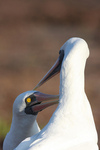Genus Sula
White booby - The Masked Booby, Sula dactylatra, is a large seabird of the gannet family, Sulidae. This species breeds on islands in tropical oceans, except in the eastern Atlantic; in the eastern Pacific it is replaced by the Nazca Booby, Sula granti, which was formerly regarded as a subspecies of Masked Booby .
Nazca booby - It was formerly regarded as a subspecies of the Masked Booby but the Nazca Booby is now recognized as a separate species. They differ in regard to ecological and morphological
Brown booby - Their heads and backs are black, and their bellies are white. Their beaks are quite sharp and contain many jagged edges. They have short wings and long, tapered tails.
Blue-footed booby - The name booby comes from the Spanish term bobo, which means "stupid" or "fool"/"clown". This is because the Blue-footed Booby is clumsy on the land, and , they can be very tame and therefore easily captured, killed, and eaten by humans.
Red-footed booby - The Red-footed Booby, Sula sula, is a large seabird of the gannet family, Sulidae. They are powerful and agile fliers, but they are clumsy in takeoffs and landings.
Sula tasmani - The Tasman Booby or Lord Howe Masked Booby is a large seabird of the gannet family, Sulidae, described from bones found on Norfolk and Lord Howe Islands in the Tasman Sea . It was believed to have become extinct in the late 18th century or early 19th century on Lord Howe Island because of predation by visiting sailors, with the last sight record dating from 1788, when it was already extinct on Norfolk Island.
Peruvian Booby - After ENSO 1982-83, less than 0.2 million birds were left. Peruvian Booby population was recovering since 1984 and reached in 1996 more than 2.6 million birds. ENSO 1997-98 started after most boobies finished the breeding season and caused a southward migration of birds. The number of Peruvian Boobies in Peru decreased through 1997 in about 87.1% due to this reason, few birds were found dead along the coast.






